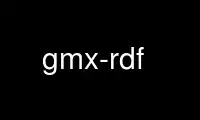
This is the command gmx-rdf that can be run in the OnWorks free hosting provider using one of our multiple free online workstations such as Ubuntu Online, Fedora Online, Windows online emulator or MAC OS online emulator
PROGRAM:
NAME
gmx-rdf - Calculate radial distribution functions
SYNOPSIS
gmx rdf [-f [<.xtc/.trr/...>]] [-s [<.tpr/.gro/...>]] [-n [<.ndx>]]
[-o [<.xvg>]] [-cn [<.xvg>]] [-b <time>] [-e <time>]
[-dt <time>] [-tu <enum>] [-xvg <enum>] [-[no]rmpbc]
[-[no]pbc] [-sf <file>] [-selrpos <enum>] [-seltype <enum>]
[-bin <real>] [-[no]norm] [-[no]xy] [-[no]excl] [-cut <real>]
[-rmax <real>] [-surf <enum>] [-ref <selection>]
[-sel <selection>]
DESCRIPTION
gmx rdf calculates radial distribution functions from one reference set of position (set
with -ref) to one or more sets of positions (set with -sel). To compute the RDF with
respect to the closest position in a set in -ref instead, use -surf: if set, then -ref is
partitioned into sets based on the value of -surf, and the closest position in each set is
used. To compute the RDF around axes parallel to the z-axis, i.e., only in the x-y plane,
use -xy.
To set the bin width and maximum distance to use in the RDF, use -bin and -rmax,
respectively. The latter can be used to limit the computational cost if the RDF is not of
interest up to the default (half of the box size with PBC, three times the box size
without PBC).
To use exclusions from the topology (-s), set -excl and ensure that both -ref and -sel
only select atoms. A rougher alternative to exclude intra-molecular peaks is to set -cut
to a non-zero value to clear the RDF at small distances.
The RDFs are normalized by 1) average number of positions in -ref (the number of groups
with -surf), 2) volume of the bin, and 3) average particle density of -sel positions for
that selection. To only use the first factor for normalization, set -nonorm. In this case,
the RDF is only scaled with the bin width to make the integral of the curve represent the
number of pairs within a range. Note that exclusions do not affect the normalization: even
if -excl is set, or -ref and -sel contain the same selection, the normalization factor is
still N*M, not N*(M-excluded).
For -surf, the selection provided to -ref must select atoms, i.e., centers of mass are not
supported. Further, -nonorm is implied, as the bins have irregular shapes and the volume
of a bin is not easily computable.
Option -cn produces the cumulative number RDF, i.e. the average number of particles within
a distance r.
OPTIONS
Options to specify input files:
-f [<.xtc/.trr/...>] (traj.xtc) (Optional)
Input trajectory or single configuration: xtc trr cpt gro g96 pdb tng
-s [<.tpr/.gro/...>] (topol.tpr) (Optional)
Input structure: tpr gro g96 pdb brk ent
-n [<.ndx>] (index.ndx) (Optional)
Extra index groups
Options to specify output files:
-o [<.xvg>] (rdf.xvg)
Computed RDFs
-cn [<.xvg>] (rdf_cn.xvg) (Optional)
Cumulative RDFs
Other options:
-b <time> (0)
First frame (ps) to read from trajectory
-e <time> (0)
Last frame (ps) to read from trajectory
-dt <time> (0)
Only use frame if t MOD dt == first time (ps)
-tu <enum> (ps)
Unit for time values: fs, ps, ns, us, ms, s
-xvg <enum> (xmgrace)
Plot formatting: none, xmgrace, xmgr
-[no]rmpbc (yes)
Make molecules whole for each frame
-[no]pbc (yes)
Use periodic boundary conditions for distance calculation
-sf <file>
Provide selections from files
-selrpos <enum> (atom)
Selection reference positions: atom, res_com, res_cog, mol_com, mol_cog,
whole_res_com, whole_res_cog, whole_mol_com, whole_mol_cog, part_res_com,
part_res_cog, part_mol_com, part_mol_cog, dyn_res_com, dyn_res_cog, dyn_mol_com,
dyn_mol_cog
-seltype <enum> (atom)
Default selection output positions: atom, res_com, res_cog, mol_com, mol_cog,
whole_res_com, whole_res_cog, whole_mol_com, whole_mol_cog, part_res_com,
part_res_cog, part_mol_com, part_mol_cog, dyn_res_com, dyn_res_cog, dyn_mol_com,
dyn_mol_cog
-bin <real> (0.002)
Bin width (nm)
-[no]norm (yes)
Normalize for bin volume and density
-[no]xy (no)
Use only the x and y components of the distance
-[no]excl (no)
Use exclusions from topology
-cut <real> (0)
Shortest distance (nm) to be considered
-rmax <real> (0)
Largest distance (nm) to calculate
-surf <enum> (no)
RDF with respect to the surface of the reference: no, mol, res
-ref <selection>
Reference selection for RDF computation
-sel <selection>
Selections to compute RDFs for from the reference
Use gmx-rdf online using onworks.net services
